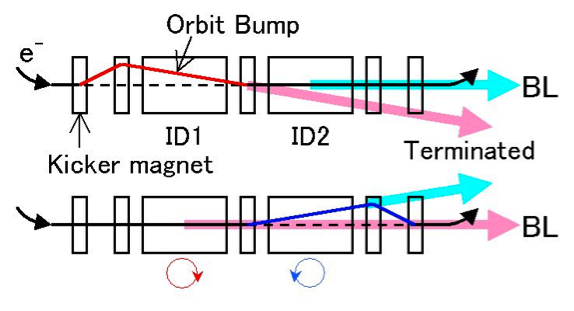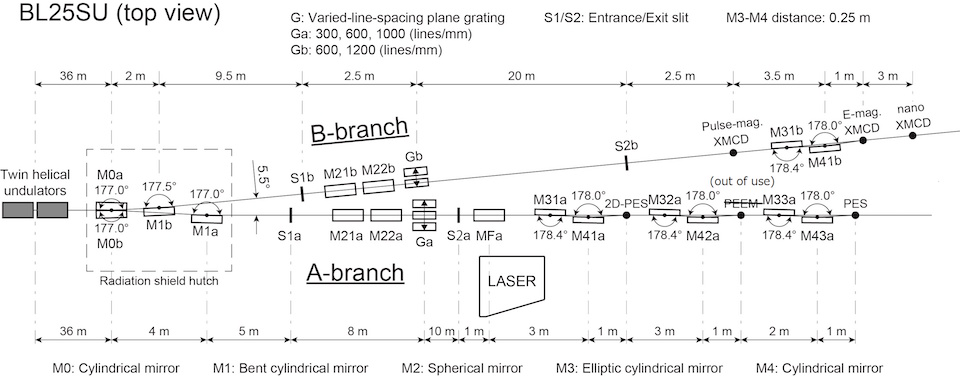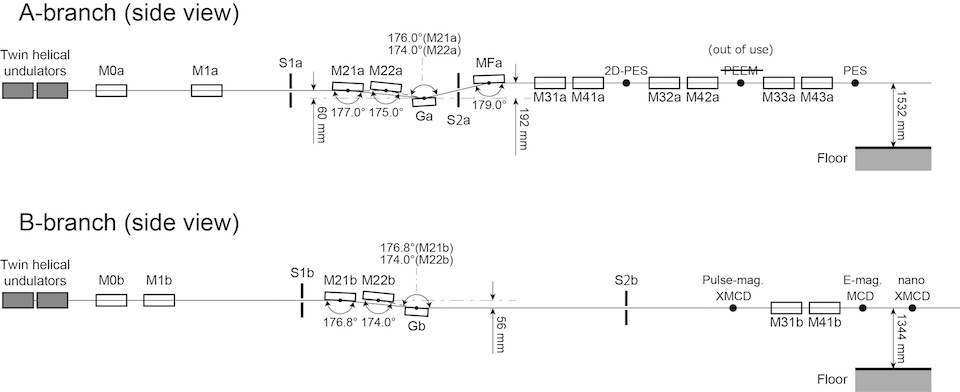BL25SU OUTLINE
問い合わせ番号
INS-0000000337
ABSTRACT
The BL25SU has two branched beamlines, called the high-energy resolution beam branch (branch A) and the high photon flux beam branch (branch B), respectively. The BL25SU optical system is designed for research elucidating electronic and magnetic states, and the surface structure of solids. The soft X-ray source is twin-helical undulators composed of a pair of helical undulators (1.5 m-length for each) which selectively produce right- or left-hand circularly polarized soft X-ray beams. The helicity of the circular polarizatio0n can be switched periodically (0.1, 1 and 10 Hz modes are available), using a kicker magnet system. Either branch A or branch B is used at any one time by switching pre-focusing mirrors. In the branch A, Retarding field analyzer (RFA), an angle-resolved photoemission electron spectroscopy (ARPES), and low-energy electron/photoelectron microscope (SPELEEM) systems are located at the end-station, and high energy resolution (E/ΔE > 10000@1 keV) soft X-rays in the range 0.12 ~ 2 keV can be used. In branch B, high flux beams (0.2 ~ 2 keV, 1012 photons/s, E/ΔE > 3000@1 keV) are utilized for the X-ray magnetic circular dichroism (XMCD) measurements. All the experiments are performed under ultra-high vacuum (10-8 ~ 10-7 Pa) conditions. Radioisotope (RI) elements and reactive gases cannot be used in this beamline.
AREA OF RESEARCH
A-branch
- Research on electronic states and band structures by angle-resolved photoemission spectroscopy (ARPES)
- Analysis of atomic arrangements by photoelectron diffraction (RFA-PED)
- Microscopic analysis of the electronic states in real space by low-energy electron/photoelectron microscope (SPELEEM)
B-branch
- Research on element-specific magnetic states by X-ray magnetic circular dichroism (XMCD)
KEYWORDS
- Scientific field
soft X-ray spectroscopy of solids, electronic structures, magnetic states, magnetic domains, atomic arrangements, magnetic dynamics - Equipment
twin helical undulators, soft X-ray monochromator with varied-line-spacing plane gratings, angle-resolved photoemission analyzer, equipment for X-ray magnetic circular dichroism, two-dimensional photoelectron analyzer for PED
SOURCE AND OPTICS
- Beamline
The synchrotron light is exclusively introduced to either A- or B-branch at the uppermost stream in a shielded optics hutch, by moving a mirror stage equipped with vertical focusing mirrors (M0a, M0b). The synchrotron light is horizontally focused by a mechanical bent mirror (M1*) and then monochromatized by a spherical mirror (M21 or M22) and a varied-line-spacing plane grating (G). According to the experimental purpose, the available energy range can be selected by choosing the particular combination of M2 and G. The entire optics is designed to obtain high energy resolution (E/ΔE> 10000@1 keV) in the A-branch and high photon flux (~1012 photons/sec) in the B-branch. The synchrotron light beam is kept horizontal (A-branch: ~1532 mm-height, B-branch: ~1344 mm) after being extracted from a planation mirror (MFa, A-branch) or the grating (Gb, B-branch). The beam is refocused by post-focusing mirrors (M31~33 and M41~43) installed just in front of each apparatus. In the A-branch, RFA and PES apparatuses are installed. The B-branch is aimed at the research using electro-magnet XMCD system. Typical beam sizes on the experimental samples are ten 〜 one-hundred microns in the A-branch, several-ten 〜 -hundred microns in the B-branch.
* In the figure below, an index “a” or “b” is added for the names of optical components to show the belonging beam branch.
- X-rays at Sample
A-branch B-branch Energy range 0.12 〜 2.0 keV 0.2 〜 2.0 keV Energy resolution(in ideal settings) E/ΔE > 10000 E/ΔE > 3000 Photon flux 〜1011 photons/s 〜1012 photons/s Beam size 10 µm 〜 several 100 µm, depending on apparatuses
*All the parameters may vary depending on settings of the optical components. Please ask for details.
EXPERIMENTAL STATIONS
A-branch
- ARPES
- RFA-PED
- SPELEEM
B-branch
PUBLICATION SEARCH
* Sorry, Some parts of results are displayed using Japanese characters.
CONTACT INFORMATION
*For e-mail addresses, add "@spring8.or.jp." after the accounts.
Naomi KAWAMURA
SPring-8 / JASRI
1-1-1 Kouto, Sayo-cho, Sayo-gun, Hyogo 679-5198
Phone : +81-(0)791-58-0833
Fax : +81-(0)791-58-0830
e-mail : naochan
Kohei YAMAGAMI
SPring-8 / JASRI
1-1-1 Kouto, Sayo-cho, Sayo-gun, Hyogo 679-5198
Phone : +81-(0)791-58-0833
Fax : +81-(0)791-58-0830
e-mail : kohei.yamagami


